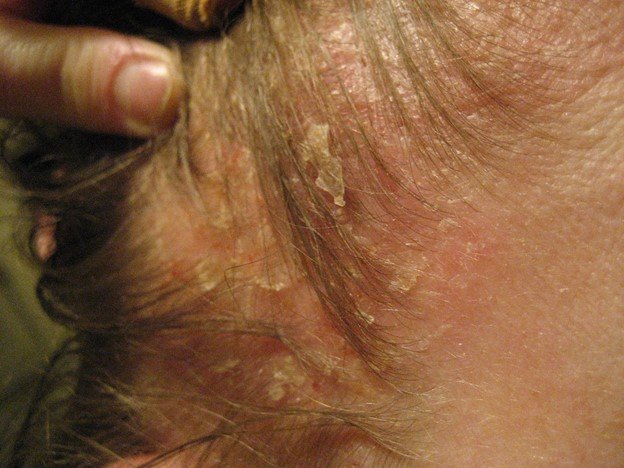Seborrheic Dermatitis
Overview:
Seborrheic dermatitis, more commonly known as dandruff, is a common scalp disorder that results in redness, inflammation, and scaling of the scalp. While many people think of seborrheic dermatitis as resulting from a dry scalp, it is actually linked more to overgrowth of a fungus / yeast called malassezia. When the scalp is very inflamed, treatment consists of anti inflammatory topical steroid solutions. Maintenance therapy consists of antifungal shampoos and leave in creams. In severe cases oral antifungals may be used. While seborrheic dermatitis can be treated, there is no permeant cure. In this article we will focus on causes, symptoms, diagnosis, treatment, and prognosis of seborrheic dermatitis.
Causes:
Seborrheic dermatitis / dandruff can be caused by a number of different factors, including genetics, climate, stress, and certain skin conditions. People who live in cold, dry climates are more susceptible to dandruff, as are people who have oily skin or scalp. Stress and certain skin conditions can also trigger dandruff. Seborrheic dermatitis / dandruff is primarily linked to an overgrowth of malassezia, a fungus / yeast that lives on the skin. Malassezia thrives in oily skin and produces by products that are very irritating to the scalp. In many patients with seborrheic dermatitis / dandruff, the body develops a strong inflammatory response to malassezia and its by products. Some people respond more robustly than others. Seborrheic dermatitis is more common in patients with neurologic disorders and HIV.
Symptoms:
Seborrheic dermatitis / dandruff is characterized by redness and scaling on oily parts of the body. It most commonly affects the scalp, however, it can also affect the corners of the nose, ears, and around the eyes.
Source: https://www.flickr.com/photos/adaenn/2285532644
License: Attribution-NonCommercial 2.0 Generic (CC BY-NC 2.0)
Source: https://commons.wikimedia.org/wiki/File:Excessive_dandruff.jpg
License: Hmochoa95, CC BY-SA 3.0 <https://creativecommons.org/licenses/by-sa/3.0>, via Wikimedia Commons
Diagnosis
Seborrheic dermatitis / dandruff is diagnosed by a dermatologist after a history and physical examination. It is important to distinguish seborrheic dermatitis / dandruff from psoriasis as psoriasis can have other systemic associations such as joint pain and metabolic disease. While psoriasis causes scaling, it typically occurs in more discrete red raised plaques than diffuse less while defined scale with seborrheic dermatitis.
Treatment
Dandruff is generally not a serious condition, but it can be uncomfortable and embarrassing. The good news is that dandruff can be treated with a variety of different therapies.
When the scalp is red and inflamed, topical steroid solutions are often the first step in reducing redness and inflammation. These can be used once or twice daily for up to weeks to improve symptoms. For maintenance, antifungal shampoos and creams can be effective by reducing levels of malassezia.
In severe cases of dandruff, oral antifungal medications may be necessary. In most cases, however, dandruff can be controlled with topical therapies including prescription as well as over-the-counter treatments. Common over the counter active ingredients include selenium sulfide, zinc, and ketoconazole.
Prognosis
While dandruff can be treated, there is no cure. The goal of treatment is to manage symptoms and prevent dandruff from recurring. With proper treatment, dandruff can be controlled and managed effectively.

